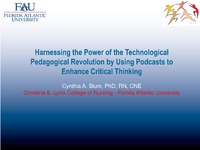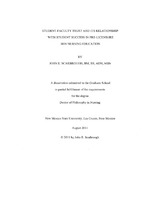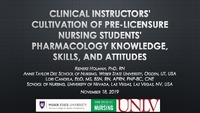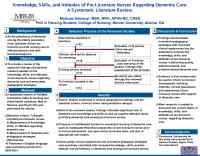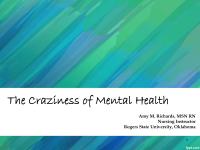| dc.contributor.author | Blum, Cynthia | en |
| dc.date.accessioned | 2016-03-17T12:57:34Z | |
| dc.date.available | 2016-03-17T12:57:34Z | |
| dc.date.issued | 2016-03-17 | |
| dc.identifier | INRC15L09 | en |
| dc.identifier.uri | http://hdl.handle.net/10755/601863 | |
| dc.description | <p>Research Congress 2015 Theme: Question Locally, Engage Regionally, Apply Globally. Held at the Puerto Rico Convention Center.</p> | en |
| dc.description.abstract | <p>Session presented on Monday, July 27, 2015:</p>
<p><strong>Purpose: </strong>Research findings from a recent study using podcasts to support nurse preceptors conducted by the Principal Investigator (PI) indicate that faculty and preceptors identify critical thinking as an area in which senior students would benefit from using podcast technology. The aim of this research study was to determine if a podcast focused on critical thinking (CT) is an effective intervention to teach critical thinking skills to senior nursing students. The dose (number of times the podcasts were viewed) to effect change was measured. Demographic variables, specifically non-native English speakers and age group, and their relationship on change in CT were determined.</p>
<p><strong>Methods:</strong> A quasi-experimental pretest/posttest with a control group design has been used. The tools used for this study are the CalifoRN Critical Thinking Skills Test (CCTST) and a demographic questionnaire. Two student groups totaling 24-36 students took the CCTST prior to and at the conclusion of their senior practicum course and completed a demographic questionnaire. The next semester, an additional two student groups took the CCTST prior to and at the conclusion of their senior practicum course except these students had access to a podcast focused on critical thinking skills. Changes in CT and the relationship to demographic factors for each group were measured.</p>
<p><strong>Results:</strong> Research data has been obtained and is in process of extensive analysis to support or refute the following aims; 1. Identify the difference in critical thinking ability for students who receive an educational podcast compared to those who receive standardized education. 2. Evaluate the relationship between dose (number of times viewed) and effectiveness for the educational podcast. 3. Identify the demographic factors (native language, age) related to change in critical thinking after viewing an educational podcast. To test the first hypothesis, Students who receive an educational podcast will have a greater increase for critical thinking ability than students who receive standardized education, data from the CCTST will be analyzed considering the overall score as well as the subscales. Change in pre/post scores from the students who did not receive access to the podcast will be compared to those who did view the podcast. To test the second hypothesis, An increased dose (number of times viewed) will have a positive relationship on gains in critical thinking ability, only the student participants who had access to the podcasts will be considered. The number of times the podcast was viewed and the mode of viewing (PHF website or YouTube' site) will be reported on the demographic questionnaire. These numbers will be correlated to changes in overall and subscale CCTST scores using regression analysis. To test the final hypothesis, There will be a relationship between demographic factors and changes in critical thinking ability for students who viewed an educational podcast, only the student participants who had access to the podcasts will be considered. The demographic factors, specifically, native language and age, will be reported on the demographic questionnaire. These numbers will be correlated to changes in overall and subscale CCTST scores using regression analysis. There are two main stages for conducting the analysis and testing the research hypotheses. The first stage is the three-part preliminary analysis. In the first part of Stage One, descriptive statistics will test the normality of the data and the underlying assumptions required for parametric data analysis. The second part of Stage One describes the processes for handling missing data. The third part tests the inclusion criteria for the added covariates. The second stage is the primary analysis. Preliminary analysis. Descriptive statistics will be utilized to investigate the normality of the data. Correlations and multiple linear regression (MLR) will be used to investigate the simple and multiple relationships between the groups on age, native language, number of times viewing the podcast, and critical thinking ability of the students, as well as the assumptions of homogeneity of variances and independence of error that are required during the more sophisticated analytical techniques. Outliers and multicollinearity will be investigated using Cooks Distance, Variable Inflation Factor, and tolerance. Stage Two of the study will use a between-groups repeated measures ANOVA to test the first research hypothesis. The technique is most appropriate when comparing intervention group to control group differences for pretest and posttest changes over time. The second research hypothesis will be analyzed using multiple linear regression with full and restrictive models to reflect the question of interest. This will allow the research to control for initial starting point in critical thinking and appropriate covariates while testing for dosage effects. The third hypothesis will follow the patteRNf analysis described for the previous research hypothesis using regression analysis.</p>
<p><strong>Conclusion:</strong> The findings of this research provide guidance to educators throughout the nation regarding an innovative technological method to prepare and support nursing students. Determining an effect size of podcast use to impact critical thinking abilities will guide educators as they prepare educational materials designed to address students who are enmeshed in the use of technology. The research findings also further corroborate the notion of technology as an educational tool primarily for younger students and podcasts as an effective intervention for non-native English speakers, although the sample size proved inadequate for statistical relevance. Previous work by this PI using educational podcasts for ongoing preceptor support conjoined nursing education and nursing practice and created a publicly-available resource that is web-based and cost-free for all interested users. A library of podcasts for student use, as recommended by the participants and the community based education/practice gap committee that oversaw this work, uses emerging technologies that are cost effective and could be useful in a variety of settings. Proven effectiveness of educational podcasts for student learning offer the opportunity to expand this work to additional areas suggested by preceptors; time management, admission of patients, communication skills, and cultural aspects of care (XXXX, see preliminary studies) and areas suggested by students when collecting data for this study. Upon completion of the initial work, this video podcast is now hosted on a publically accessible website to which students access ia computer or mobile web, giving them instant access to all updates and future video podcasts while providing a resource with the potential to reach an unlimited number of nursing students and educators. A collaborative' grant to conduct the study was funded by NLN (through STTI (2013).</p> | en |
| dc.format | Text-based Document | en |
| dc.language.iso | en | en |
| dc.subject | Critical Thinking | en |
| dc.subject | Podcasts | en |
| dc.subject | Educational Technology | en |
| dc.title | Teaching critical thinking skills to pre-licensure nursing students using podcast technology | en |
| dc.title.alternative | Developing Critical Thinking through Curriculum and Technology | en |
| dc.type | Presentation | en |
| dc.rights.holder | <p>
All rights reserved by the author(s) and/or publisher(s) listed in this item record unless relinquished in whole or part by a rights notation or a Creative Commons License present in this item record.
</p><p>
All permission requests should be directed accordingly and not to the Sigma Repository.
</p><p>
All submitting authors or publishers have affirmed that when using material in their work where they do not own copyright, they have obtained permission of the copyright holder prior to submission and the rights holder has been acknowledged as necessary.
</p> | |
| dc.description.note | <p>Items submitted to a conference/event were evaluated/peer-reviewed at the time of abstract submission to the event. No other peer-review was provided prior to submission to the Henderson Repository.</p> | en |
| dc.type.category | Full-text | en |
| dc.evidence.level | N/A | en |
| dc.research.approach | N/A | en |
| dc.contributor.department | Iota Xi at-Large | en |
| dc.author.details | Cynthia Blum, RN, CNE | en |
| dc.conference.name | 26th international Nursing Research Congress | en |
| dc.conference.host | Sigma Theta Tau international | en |
| dc.conference.location | San Juan, Puerto Rico | en |
| dc.date.conferenceyear | 2015 | |
| dc.contributor.affiliation | Florida Atlantic University, Boca Raton, Florida, USA | en |
| dc.description.reviewtype | Abstract Review Only: Reviewed by Event Host | en |
| dc.description.acquisition | Proxy-submission | en |
